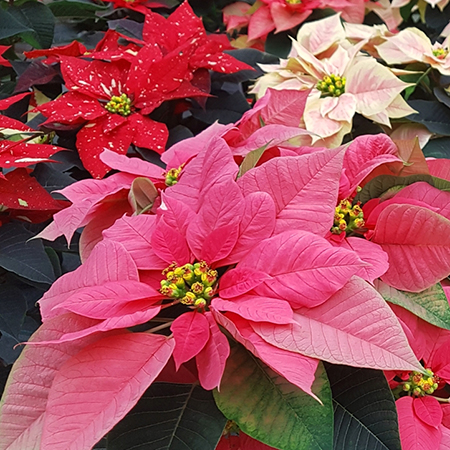I often wonder about why certain plants become embedded in holiday traditions. Undoubtedly the most celebrated in our neck of the woods is the Christmas Season which has no shortage of plants woven into its celebrations. Why do we cut Christmas trees? Adorn our tables with Pointsettias or kiss beneath the Mistletoe? When did this start and who did it first? So with that, I was off, my fingers dancing their way through the web to find answers and quell my curiosity. Here’s what I found…
Christmas Trees
No body knows! Ha! Rather anticlimactic to be sure, but it would seem that no one knows for certain who cut the first tree or exactly where the tradition started. It’s believed to have originated in Riga (the largest city in Latvia) from a some time in the late 1400’s to early 1500’s. By about 1584 it was documented as an established tradition that involved decorated spruce at the market square where the young men “went with a flock of maidens and women, first sang and danced there and then set the tree aflame”. Regardless of where they started the evergreen tree is a symbol that unites almost all the northern European winter solstices. Live trees were often brought into homes during the harsh winters as a reminder to inhabitants that soon their crops would grow again. Knowing a bit of history certainly piqued my interest and I’m not alone. It’s captured the hearts of thousands in our modern society. So much so that there is actually an enormous festival held in Riga each year, The Christmas Tree Trail to pay homage to the lore so intertwined in the city’s history.
Pointsettias
These holiday flowers actually originate from Mexico! Their connection to christmas is a little folk lore and a little fact. A man by the name of Joel Roberts Poinsett brought these lovely plants to South Carolina back in early 1800’s. He was the first Ambassador from the USA to Mexico in 1825. They flower in the winter time in their native Mexico, so the timing was perfect even in the southern states. They quickly gained popularity and the flower ‘Euphorbia pulcherrima’ was coined Pointsettia in honour of the man who delivered them to the US.
The history does not end there. An old Mexican legend gives the flower a religious twist and ties it in with the true origins of Christmas. It goes like this;
There was once a poor Mexican girl called Pepita who had no present to give the baby Jesus at the Christmas Eve Services. As Pepita walked to the chapel, sadly, her cousin Pedro tried to cheer her up. ’Pepita’, he said “I’m sure that even the smallest gift, given by someone who loves him will make Jesus Happy.”
Pepita didn’t know what she could give, so she picked a small handful of weeds from the roadside and made them into a small bouquet. She felt embarrassed because she could only give this small present to Jesus. As she walked through the chapel to the altar, she remembered what Pedro had said. She began to feel better, knelt down and put the bouquet at the bottom of the nativity scene. Suddenly, the bouquet of weeds burst into bright red flowers, and everyone who saw them was sure they had seen a miracle. From that day on, the bright red flowers were known as the ‘Flores de Noche Buena’, or ‘Flowers of the Holy Night’.
The shape of the poinsettia flower and leaves are sometimes thought of as a symbol of the Star of Bethlehem which led the Wise Men to Jesus. The red coloured leaves symbolize the blood of Christ. The white leaves represent his purity. – Story from whychristmas.com
Mistletoe
Another plant with European origins, no surprise really when we think of how young Canada and the US are in comparison. Mistletoe is a parasitic plant that latches on to trees and sends it’s roots into the branch or trunk to draw nutrients. The version we recognize from our traditions is native to North America and grows as a parasite on trees from New Jersey to Florida. So what makes us want to make out under the Mistletoe? Why would a plant with the less than desirable habit of leeching off other fauna be something that inspires romantic desire? Like the Christmas Tree it’s a little hazy exactly why but Mistletoe is credited with being able to bestow fertility. In Scandinavia, mistletoe was considered a plant of peace, under which enemies could declare a truce or warring spouses kiss and make-up. Later, the eighteenth-century English credited with a certain magical appeal called a kissing ball. At Christmas time a young lady standing under a ball of mistletoe cannot refuse to be kissed and such a kiss could mean deep romance or lasting friendship. If the girl remained un-kissed, she would not marry the following year. Even now as we continue this tradition a couple in love kissing beneath the Mistletoe is destined to marry and carries a prediction of a long and happy life.
Do you practice any special traditions in your home? We’d love to hear more about them. Drop us a line on our Facebook page or share by replying to this post.


